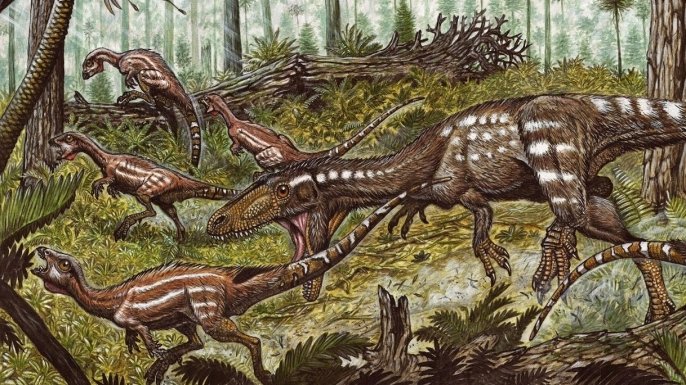
Venezuela has never been a hotspot for dinosaur remains. Yet on Wednesday, paleontologists reported the discovery of a new species there, which apparently lived in a wet, volcano-filled equatorial rift valley surrounded to the north and south by extensive deserts.
In a nod to history, paleontologists are calling the new dinosaur Tachiraptor admirabilis. The first of those names is a mash-up of Táchira, the Venezuelan state where they unearthed the fossil, and raptor, which means “thief” in Latin, whereas the second name refers to independence leader Simón Bolívar’s “Admirable Campaign.” Back in 1813, the area surrounding the dig site, located in the Andes, played an important strategic role for Bolívar as he rid the country of Spanish rule.
Thus far, Tachiraptor admirabilis is known from only two bones—a nearly complete tibia, or shinbone, fractured in several places, and a partial hip bone, according to a paper published online Wednesday in the journal Royal Society Open Science. Nonetheless, paleontologists were able to estimate the length of the creature as slightly over 1.5 meters from nose to tail, about the same as a modern-day wild boar or gray wolf. By comparison, Tyrannosaurus rex grew to around 12 meters long.
Using radiometric dating of tiny crystals within rocks, paleontologists were also able to estimate the age of the fossil at around 200 million years old. That places it in the early Jurassic period, right after a mass extinction had ended the Triassic period and around the time dinosaurs were beginning to dominate the planet. One of the groups that particularly thrived were bipedal, largely meat-eating dinosaurs known as theropods. “These survivors of the Triassic-Jurassic mass extinction were the ‘ground zero’ for later theropod evolution,” Thomas Holtz Jr., a vertebrate paleontologist at the University of Maryland, who was not involved in the study, told Science magazine.
Based on certain features of the tibia, the study’s authors speculated that Tachiraptor admirabilis, though a theropod, did not directly evolve into Allosaurus, Tyrannosaurus rex or other similar behemoths, belonging instead to a sister group. Even so, the fossil will be useful to scientists trying to flesh out the theropod family tree, which contains many gaps, according to Holtz. “Important discoveries,” he told Science magazine, “don’t have to be of the biggest or the scariest [dinosaurs].”
Partly because so few paleontologists look there, virtually no dinosaur remains had ever been found in northern South America until this August, when a team announced the discovery of Laquintasaura venezuelae, a bipedal omnivore about the size of a fox. Because it lived at exactly the same time and place as Tachiraptor admirabilis, the lead author of Wednesday’s study, Max C. Langer, speculated that it served as a food source for the larger dinosaur. “Tachiraptor was probably a generalist predator that ate anything it could get, such as small dinosaurs and other vertebrates, such as lizards,” Langer, a paleontologist at the Universidade de São Paulo in Brazil, told LiveScience.
He further explained that Tachiraptor admirabilis lived around the time the supercontinent of Pangaea was breaking up. “There was a lot of volcanic activity around, and in the valley, [there was] a meandering river, along which were patches of forest.” He and his team reportedly plan on returning soon to the Venezuelan Andes to look for more dinosaur bones.
👍
Thank...
nice story and informason @mawardi
Thank you @xpilar